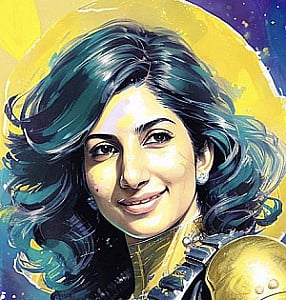English, Hindi, Rajasthani, Punjabi & any language written in English
Description
Vocal Characteristics
Language
EnglishVoice Age
Middle Aged (35-54)Accents
British (General) Indian (Hinglish)Transcript
Note: Transcripts are generated using speech recognition software and may contain errors.
This is the journey of two Australian indigenous women artists, Deborah Woke and Shane Marwa, whose trailblazing exhibition is touring India Jarara dry season wind is a collection of screen printed textiles and prints by 20 artists of the Barbara Women's Center in Man Andrea, Northern Australia. The artists draw inspiration from their country. Its geographic features, weather patterns, fauna and flora of their land using contemporary methods. They produce artwork with traditional themes and a modern flair. The visit to India by China Tantara showcases their vibrant textile designs. They are sharing design principles with groups of India's indigenous women textile artist through an immersive exchange of culture, art, ideas and knowledge. Their visit took them from the far reaches of Orissa and the Sundarbans to the opulence of Saa's flagship store in Kolkata. The first stop in India for the exhibition Chiara Dry season Wind is the city of Choy Kolkata. The Indian Museum shone a spotlight on this remarkable collection of printer textiles. The Australian consulate General Kolkata hosted a reception at the Indian Museum. Kolkata in honor of these artists, the indigenous artists from Australia traveled to Orissa and West Bengal. The Australian consulate General Kolkata facilitated these visits, enabling the artists to meet Indian indigenous women, textile artists to share their experiences, knowledge and learn from the local artists in Orissa. They went to meet and learn from an initiative undertaken by Tata Steel Foundation. In their visit to Nava and Cooperative Chenette and Deborah were given a rousing welcome. They interacted with their women cooperative members who demonstrated the practices of painting and stretching and how to produce silk thread. Chetan Debora gathered local insights about these design arts. In addition to Orissa, the Australian Consulate General Kolkata took them to Shanti Kean and the Sundar Buns in West Bengal, Shane and Debora were exposed to Tidy Kant Hostage, block printing, wax, block printing and bati in Shanti, Shane. And Deborah also visited local women artists in the Sundar Buns. Local artists presented the methods and practice of the textile production. The Australian government's indigenous diplomacy policy recognizes the importance of placing Australia's first nations knowledge at the center of Foreign policy with India's rich heritage of textiles weaving in embroidery. The Jarara exhibition resonated with Indian audiences providing a glimpse into indigenous design and providing the opportunity to tell stories of indigenous Australia. The confluence of cultural exchange created by the Jarara Tris Season Wind exhibition and the design inspiration brought by Deborah and Janet has left a lasting impression in the minds of the tribal women artists with whom they interacted. The Australian artists emphasized the importance of telling a story in each artwork, how each design had meaning for the creator. In parallel Deborah and Janet have drawn inspiration from the textiles of Barbara designs, is working with Indian woodblocks, printers to interpret some of the Jarara designs into woodblocks which will lead to further collaboration.
